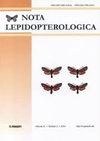阿富汗和伊朗刺蝇属二新种(鳞翅目,蠓科)
IF 0.7
4区 农林科学
Q4 ENTOMOLOGY
引用次数: 0
摘要
Spiniphallelusebertisp。11月(伊朗)和spiniphallellushumannisp。11月(阿富汗)被描述。本文简要地讨论了该属在Anomologinae亚科中的地位,以及同一属中两个物种的雄性生殖器的发育程度。文中给出了所有棘属植物的分类表,并对该新种的成虫和雌雄生殖器官进行了图解。本研究分别从哈萨克斯坦、乌兹别克斯坦和土库曼斯坦的沙漠(S.desertus Bidzilya & Karsholt, 2008)、哈萨克斯坦的山区(S.stonisi Bidzilya & Karsholt, 2008)和土耳其的山区(S.fuscescens Bidzilya & Karsholt, 2008)建立了棘虫属。最近在保加利亚、土耳其和格鲁吉亚又发现了一种新种,S.chrysotosella Junnilainen, 2016。前三个物种的外表非常相似,但很容易通过它们的生殖器区分开来。从翼展和翼型上看,金鸡的外形与其他种属截然不同,但其生殖器与属的外形非常相似,与fuscesens最相似。寄主植物已知只有沙漠草,其幼虫以哈萨克斯坦的大黄(蓼科)为食(Falkovitsh and Bidzilya 2009)。在记录该物种的三个地点,均在Jasminumfruticans L.(油科)周围观察到s.c yysotosella成虫(Junnilainen 2016)。在对卡尔斯鲁厄国家自然博物馆收集到的材料进行研究后,在阿富汗和伊朗的材料中发现了五个颜色朴素、翅膀相当窄的灰黑色革蚊科标本。通过对其生殖器的研究,证实了它们属于带刺属。事实证明,它们代表两个不同的物种,与任何已知的物种都不匹配。它们的描述如下。本文章由计算机程序翻译,如有差异,请以英文原文为准。
Two new species of Spiniphallellus Bidzilya & Karsholt, 2008 (Lepidoptera, Gelechiidae) from Afghanistan and Iran
Spiniphallelusebertisp. nov. (Iran) and Spiniphallellusnaumannisp. nov. (Afghanistan) are described. The position of the genus within the subfamily Anomologinae is briefly discussed, as is the degree of development of the gnathos in the male genitalia of two species within the same genus. A key to all Spiniphallellus species is given, and adults and male and female genitalia of the new species are illustrated.
Introduction
The genus Spiniphallellus was established for three species of Gelechiidae, respectively from the deserts of Kazakhstan, Uzbekistan and Turkmenistan (S.desertus Bidzilya & Karsholt, 2008), mountains of Kazakhstan (S.stonisi Bidzilya & Karsholt, 2008) and mountains of Turkey (S.fuscescens Bidzilya & Karsholt, 2008). Recently an additional new species, S.chrysotosella Junnilainen, 2016, was described from Bulgaria, Turkey and Georgia. The first three species are externally very similar, but can easily be separated by their genitalia. S.chrysotosella looks externally quite distinct from the other species both by its wingspan and wing pattern, but its genitalia match well the configuration for the genus, being most similar to those of S.fuscescens.
The host plant is known only for S.desertus, whose larva feeds on Rheum sp. (Polygonaceae) in Kazakhstan (Falkovitsh and Bidzilya 2009). The adults of S.chrysotosella were observed around Jasminumfruticans L. (Oleaceae) in all three localities where this species was recorded (Junnilainen 2016).
As a result of studying collected material in the Staatliches Museum für Naturkunde in Karlsruhe, five plain coloured, rather narrow-winged greyish black specimens of Gelechiidae were discovered amongst material from Afghanistan and Iran. Their assignment to the genus Spiniphallellus was proved by the study of the genitalia. It turned out that they represent two different species, which do not match any known species in the genus. Their description is given below.
求助全文
通过发布文献求助,成功后即可免费获取论文全文。
去求助
来源期刊

Nota Lepidopterologica
Agricultural and Biological Sciences-Insect Science
CiteScore
1.70
自引率
14.30%
发文量
20
审稿时长
14 weeks
期刊介绍:
Nota Lepidopterologica is the scientific, peer-reviewed journal of the Societas Europaea Lepidopterologica (SEL). It publishes original contributions to the study of mainly but not exclusively Palaearctic Lepidoptera, especially on taxonomy, morphology/anatomy, phylogenetics, biogeography, ecology, behaviour, and conservation, but also on any other aspects of lepidopterology.
All articles are published in English, with the possibility of having the summary written in other languages. All submitted manuscripts are subject to peer-review by the leading specialists for the respective topic. The journal is published in open access high-resolution PDF, semantically enriched HTML and machine-readable XML versions.
All papers can be freely copied, downloaded, printed and distributed at no charge. Authors and readers are thus encouraged to post the pdf files of published papers on homepages or elsewhere to expedite distribution. Publication is free for the SEL members and there is no charge for color.
 求助内容:
求助内容: 应助结果提醒方式:
应助结果提醒方式:


